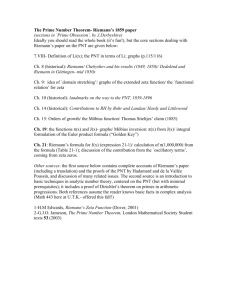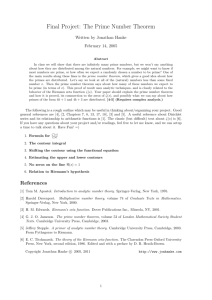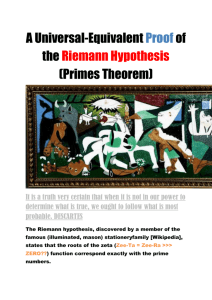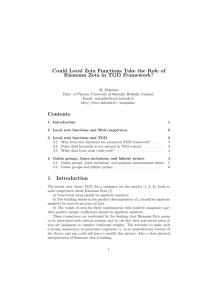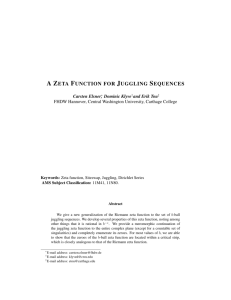What is a zeta function?
advertisement
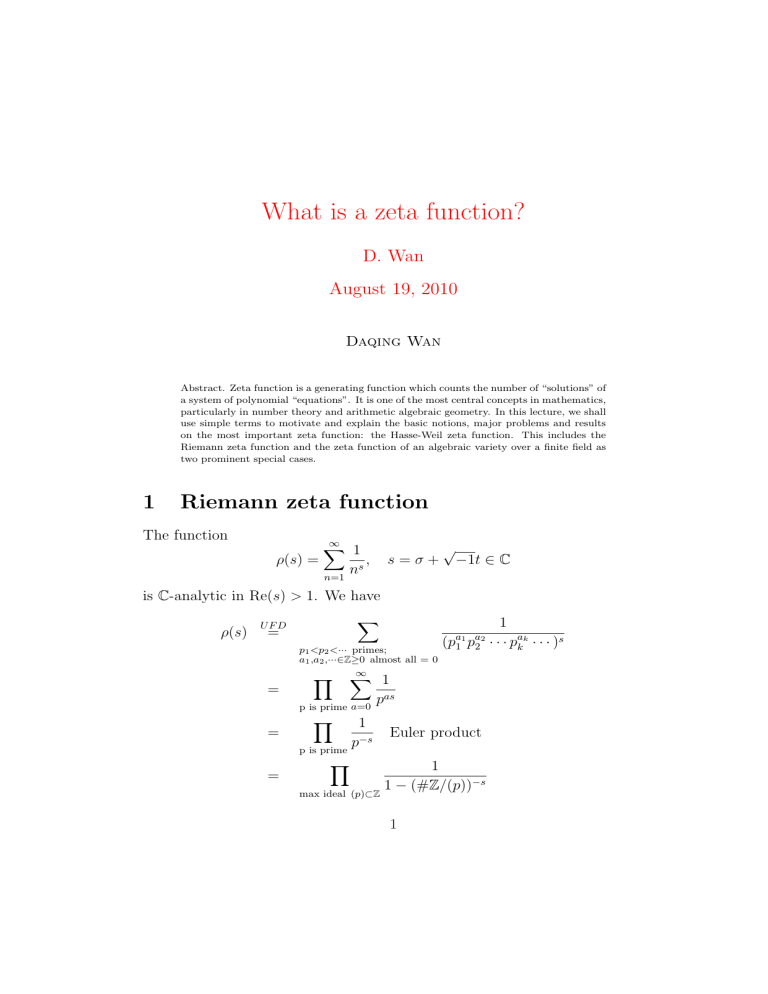
What is a zeta function?
D. Wan
August 19, 2010
Daqing Wan
Abstract. Zeta function is a generating function which counts the number of “solutions” of
a system of polynomial “equations”. It is one of the most central concepts in mathematics,
particularly in number theory and arithmetic algebraic geometry. In this lecture, we shall
use simple terms to motivate and explain the basic notions, major problems and results
on the most important zeta function: the Hasse-Weil zeta function. This includes the
Riemann zeta function and the zeta function of an algebraic variety over a finite field as
two prominent special cases.
1
Riemann zeta function
The function
∞
X
1
ρ(s) =
,
ns
n=1
s=σ+
√
−1t ∈ C
is C-analytic in Re(s) > 1. We have
ρ(s)
X
UF D
=
=
p1 <p2 <··· primes;
a1 ,a2 ,···∈Z≥0 almost all = 0
∞
Y X
p is prime a=0
=
=
(pa11 pa22
1
pas
Y
1
p−s
p is prime
Y
max ideal (p)⊂Z
Euler product
1
1 − (#Z/(p))−s
1
1
· · · pakk · · · )s
Hence ρ(s) is a generating function for counting primes.
Theorem 1.1 (Riemann, 1859) ρ(s) extends to a C-meromorphic function in s ∈ C, with a simple pole at s = 1, satisfying a functional equation
for s and 1 − s.
RH (Riemann Hypothesis) If ρ(s) = 0 for some s ∈ C, then Re(s) ∈ 12 Z,
i.e., non-trivial zones s satsify Re(s) = 21 .
Definition 1.2 For t > 0, define
π(t) = #{1 ≤ p ≤ t | p is a prime}.
Theorem 1.3 (Prime Number Theorem)
t
(1 + o(1)).
ln t
π(t) =
This implies that
Z
2
t
1
dx
ln x
should be a good approximation of π(t).
Z
t
1
1
RH ⇔ π(t) =
dx + o(t 2 +ε ) for any ε > 0
ln x
¯
¯ √
Z2 t
¯
¯
1
x ln x
¯
⇔ ¯π(t) −
dx¯¯ <
, ∀ x ≥ 2657.
8π
2 ln x
It is known that
Z
π(t) =
2
t
Ã
Ã
3
5
1
A(ln x)
dx + O x exp −
1
ln x
ln ln x 5
!!
RH has many other applications in number theory and computer sciences.
2
2
Hasse-Weil zeta function
Let A be a finitely generated commutate Z-algebra:
A
=
Hilbert basis thm
=
Z[x1 , · · · , xn ]/I,
I is an ideal
Z[x1 , · · · , xn ]/(f1 , f2 , · · · , fm ),
where fi = fi (x1 , x2 , · · · , cn ) ∈ Z[x1 , x2 , · · · , xn ].
Let X = Specm(A) be the set of prime ideals of A, and |X| = Specm(A)
be the set of maximal ideals of A. Then |X| is also the set of closed points
of X.
If x ∈ |x|, then A/X is a f.g. field over Z, hence a finite filed Fpk for some
prime p with k ∈ Z≥1 .
Definition 2.1 The Hasse-Weil zeta function of A or X is
Y
1
ρ(A, s) =
.
−s
1
−
(#A/x)
x∈X
This function is C-analytic in Re(s) > dim(X).
Conj I (meromorphic continuation) ρ(A, s) extends to a meromorphic function in s ∈ C.
Conj II (GRH) If ρ(A, s) = 0 or ∞ for some s ∈ C, then Re(s) ∈ 12 Z.
Example 2.2 If A = Z, then ρ(Z, s) = ρ(s) is Riemann zeta function.
Example 2.3 If A = Z[x]/(f (x)) with f (x) ∈ Z(x) being irreducible and
deg(f ) = d ≥ 1, then ρ(A, s) is the Dedekind zeta function of K = Q(α), in
which f (α) = 0.
In this case, Conj I is known, but Conj II is open (no single case is
known).
Example 2.4 If A = Z[x, y]/(y 2 − x3 − ax − b), where a, b ∈ Z such that
y 2 = x3 + ax + b defines an elliptic curve E over Q, then rho(A, s) is the
Hasse-Weil zeta function of E.
In the case, Conj I is known (⇔ Taniyann-Shinorn Conjeture ⇒ Fermat’s last theorem), but Conj II is open.
3
3
Zeta function over finite fields
Assume p ∈ I for some prime ρ > 0. Then
A = Fp [x1 , x2 , · · · , xn ]/I = Fp [x1 , x2 , · · · , xn ]/(f1 , f2 , · · · , fm ),
where fi ∈ Fp [x1 , x2 , · · · , xn ].
Recall X is the set of maximal ideals of A. For x ∈ A with deg(x) ∈ Z≥1 ,
A/x is a finite field that is an extension of Fp . Denote this field by Fpdeg(x) .
There is an reduction homomorphism
φx : Fp [x1 , x2 , · · · , xn ] → Fpdeg(x) = A/x
xi → x̄i = xi ∈ Fpdeg(x) ,
and fi ∈ I ⊆ Ker(φx ).
For all 1 ≤ i ≤ n,
fi (x1 , x2 , · · · , xn ) = 0,
fi (xp1 , xp2 , · · · , xpn ) = 0,
..
.
deg(x)−1
pdeg(x)−1
pdeg(x)−1
fi (x1
, x2
, · · · , xnp
) = 0.
Thus, a maximal ideal x ∈ A ⇔ the p-orbit of a geometric point of
{f1 = f2 = · · · = fm = 0}
in Fp (algebraic closure).
Let
Nr (x) = #{(x1 , x2 , · · · , xn ) ∈ Fnpk | fi (x1 , x2 , · · · , xn ) = 0,
4
∀ 1 ≤ i ≤ n}
Then,
ρ(A, s)
=
=
p−s =T
=
=
=
=
Y
x∈|x|
∞
Y
k=1
∞
Y
1
1 − (#A/x)s
1
(1 −
pks )Mk (x)
1
(1 − T k )Mk (x)
k=1
(Mk = # of closed points of degree k)
∞
k X
X
T
exp
d Mk (x) , T = p−s
k
k=1
d|k
!
̰
X Tk
Nk (x)
exp
k
k=1
Z(X, T ).
Weil conjecture (1949)
I (Dwork,1960), Z(x, T ) ∈ Q(T ) is equal to
Qa
(1 − αi T )
,
Qbi=1
(1
−
β
T
)
i
j=1
i.e.,
Nk (X) =
b
X
k=1
βjk −
a
X
αik ,
k = 1, 2, 3, · · ·
i=1
Corollary 3.1 Conj I holds in chor p, ρ(A, s) = Z(x, p−s ) is C-meromorphic
in s ∈ C.
II(Deligne,1980), write
Qa
Z(x, T ) ∈ Q(T ) = Qbi=1
(1 − αi T )
j=1 (1
5
− βi T )
in reduced form, αi , βj ∈ C. Then
p
(p)ui , ∀ σ ∈ Gal(Q/Q)
p u
|βj | = |σ(αj )| = (p) j , ∀ σ ∈ Gal(Q/Q)
|αi | = |σ(αi )| =
where 0 ≤ ui , uj ∈ Z.
Corollary 3.2 Conj II holds, in chor p. If
Qa
(1 − αi T )
−s
ρ(A, s) = Z(x, p ) = Qbi=1
j=1 (1 − βi T )
equals to 0 or ∞ for some s ∈ C, then Re(s) ∈ 21 Z.
III For a prime number l, Q is the field of l-adic algebraic numbers. Write
Y
z(x, T ) =
(1 − αi T )±1
in reduced form, where αi ∈ Qe . Then
½
1,
if l 6= p(Delige);
|αi |l =
si
p , si ∈ Q, if l = p.
Here si is the p-slope of αi .
This remains an active research area, related to Hodge theory.
6







